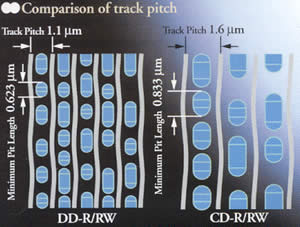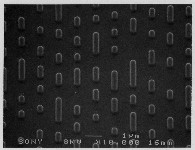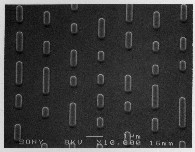Sony CRX200E DDCD-RW
1. Introduction
Review Pages
Sony CRX 200E IDE DDCDR-W - Page 1
Introduction:
Sony has been the company that, alongside with Philips, have developed most
of the well known CD patterns. On July 2000 Sony announced a new CD format called
"Double Density", which promised to double (X2 times) the existing
CD capacity up to 1.3GB. The new format has been described by the new "Purple
Book" standard. In their initial press release, Sony stated:
 "...The
Double Density CD formats are designed to provide a natural migration path for
both consumers and manufacturers alike, as the new formats offer a low-cost
solution to high capacity discs that inherit the basic specifications of the
CD formats. This allows manufacturers to utilize their current CD technologies
and production facilities to manufacture Double Density CDs. The recent evolution
of high performance processors and high capacity hard disk drives has empowered
the PC to handle large audio, video and still image files. That in turn has
raised the need for higher capacity CDs to store and share those files with
other devices at the lowest running cost. In light of this market demand, Sony
decided to develop the Double Density CD formats. The target market of CRX-200E-RP
is 5% of high-end CD-R/RW after market, which is estimated approximately 17
million units world wide at the initial stage..."
"...The
Double Density CD formats are designed to provide a natural migration path for
both consumers and manufacturers alike, as the new formats offer a low-cost
solution to high capacity discs that inherit the basic specifications of the
CD formats. This allows manufacturers to utilize their current CD technologies
and production facilities to manufacture Double Density CDs. The recent evolution
of high performance processors and high capacity hard disk drives has empowered
the PC to handle large audio, video and still image files. That in turn has
raised the need for higher capacity CDs to store and share those files with
other devices at the lowest running cost. In light of this market demand, Sony
decided to develop the Double Density CD formats. The target market of CRX-200E-RP
is 5% of high-end CD-R/RW after market, which is estimated approximately 17
million units world wide at the initial stage..."
- How did they do it?
 The
high capacity of the Double Density CD format is realized by a few simple modifications
to the common CD format. In order to increase data density, track-pitch and
minimum pit length are miniaturized to increase the data capacity from 650MB
to 1.3GB. This capacity is achieved by utilising a conventional
780 nm laser and using a NA of 0.50 or 0.55, thus reducing the track pitch (by
1.45) and the minimum pit size (by 1.33):
The
high capacity of the Double Density CD format is realized by a few simple modifications
to the common CD format. In order to increase data density, track-pitch and
minimum pit length are miniaturized to increase the data capacity from 650MB
to 1.3GB. This capacity is achieved by utilising a conventional
780 nm laser and using a NA of 0.50 or 0.55, thus reducing the track pitch (by
1.45) and the minimum pit size (by 1.33):


 >
>
|
Comparison of DDCD and CD formats
|
||
|
Double Density CD
|
Conventional CD
|
|
|
Data Capacity
|
1.3GB (2048 B/sector)
|
CD-ROM (Mode1)/-R/-RW: 650MB (2048 B/Sector)
|
|
Wavelength
|
780nm780nm
|
|
|
Objective Lens
|
Read: NA=0.50
Read/Write: NA=0.55 |
Read: NA=0.45
Read/Write: NA=0.50 |
|
Disc Size
|
Diameter: 120mm, 80mm
Thickness: 1.2mm |
|
|
Track Pitch
|
1.1micrometer
|
1.6micrometer
|
|
Minimum Pit Length
|
0.623micrometers
|
0.833micrometers
|
|
Scanning Velocity
|
0.90 m/s
|
1.2 to 1.4 m/s
|
|
Error Correction
|
CIRC7
|
CIRC
|
|
Modulation
|
EFM
|
|
To accommodate higher physical bit density, a parameter in the error-correction scheme (CIRC) has been changed, and the address format (ATIP) has been expanded. Sony stated in the original press release that "...A copy control scheme will be included in the format to meet the increasing demands for secure content protection...".
This copy control scheme, as we can understand, means that you can not write AudioCD format in DDCD-R/RW media! Yeap folks. Sony denied any relation of the DDCD format with Audio CDs (and with all possible piracy issues). Just imagine that a DDCD-R media will be able to store 148mins of music... Someone might say that this is not a real problem since DDCD media is not playable from current stand alone players/CD-ROMs. That is true for the present situation, but what about the future? Sony's future CD-ROMs/CDR-W drive will probably support the DDCD format, and then this *problem* will become a reality. Of course you are able to write Mp3 files (as data tracks).
 -
Media:
-
Media:
 The
DDCD media can be either 80mm and/or 120 mm disc size. There will be 3 types
of DDCD media: Read Only (DDCD-ROM), Write Once (DDCD-R), and Rewritable (DDCD-RW)
with the same capacities. As you can understand, due to different physical structure,
the DDCD Medium is not backwards compatible with the existing CD-ROM/DVD-ROM/CDR-W
drives. This means that the media will only be playable in the devices that
contains the "DDCD" logo.
The
DDCD media can be either 80mm and/or 120 mm disc size. There will be 3 types
of DDCD media: Read Only (DDCD-ROM), Write Once (DDCD-R), and Rewritable (DDCD-RW)
with the same capacities. As you can understand, due to different physical structure,
the DDCD Medium is not backwards compatible with the existing CD-ROM/DVD-ROM/CDR-W
drives. This means that the media will only be playable in the devices that
contains the "DDCD" logo.
 For
now there are not many manufacturers who ship DDCD-R/RW media. Only Sony and
Verbatim sell DDCD-R/RW, and we haven't heard of any other media manufacturers
going for it. Actually even Verbatim have announced DDCD media they haven't
shipped in retail market due to low demand. Our guess is that they are waiting
to see whether the new standard will be widely accepted from end users, in order
to proceed to mass production. Below is a comparison chart beetween the CD/DDCD
formats and the media that can be read/written:
For
now there are not many manufacturers who ship DDCD-R/RW media. Only Sony and
Verbatim sell DDCD-R/RW, and we haven't heard of any other media manufacturers
going for it. Actually even Verbatim have announced DDCD media they haven't
shipped in retail market due to low demand. Our guess is that they are waiting
to see whether the new standard will be widely accepted from end users, in order
to proceed to mass production. Below is a comparison chart beetween the CD/DDCD
formats and the media that can be read/written:

As you may notice the DDCD drives can playback all CD media and DDCD media. The normal CD-RW drives simply cannot read the DDCD-R/RW media.
- Recording methods:
The DDCD format is supposed to support: "DAO, SAO, TAO" formats.
Our tests showed that only "TAO" writing mode, Packet Writing and
Multi-Session are supported. In the case of Packet Writing we will have 2 modes:
Variable Packet Writing and Fixed Packet Writing (no futher information
is given about their main differences). There seems to be a limitation with
MultiSession of the DDCD and CD format as the following table shows:

As it is obvious, you cannot backup CDs which contain multiple sessions in DDCD-R/RW media, and vice versa.
- Recording speeds:
The DDCD format has mainly 2 different writing/re-writing speeds. The DDCD-R
media can be written at 12x and the DDCD-RW media at 8x. In other words, you
will need around 12 minutes to burn a full DDCD and around 15 minutes for a
full DDCD-RW media. We hope that newer DDCD models will support higher recording
speeds (16x) and, why not, a full 10x re-write mode.
- Use:
The product sheet of CRX200E model says that you can:
- Backup your most important files
- Store large or high quality digital photos
- Move your favorite music tracks from your HD
- Store 2 hours MPEG-1 digital motion pictures
- Store Internet homepage's multimedia contents
- Distribute and share data
Have you noticed that almost every single use contains the word "store" and "backup"? This is where the DDCD is aimed at!
- Future:
We cannot say much about the new CD standard from Sony and Philips, at least
for now... Only time will tell. The main problem is that the DVD-R recording
format is here, even in not so affordable prices for the masses (1000$ for the
drive and around 10$ for the blanks). On the other hand, the DDCD format offers
lower capacity (1.3GB) BUT at a much lower initial price cost (249$) and of
course the media is very cheap (2-3$).
Don't forget about the licence patterns: In order for someone to use the new DDCD format, he is oblidged to pay fees to Sony and Philips. If prices are low maybe someone will be interested in supplying such drives, but so far no other manufacturer have announched anything...Therefore we must see the DDCD format not as a CD standard that tends to replace the existing CD or possible DVD-R/RW formats, but as a new proposal mainly for backup proposes. I know many people who wish to have some extra MBs in their 74 or 80 minute CDs to fit more data. The DDCD is designed to satisfy the needs of those people.
- Wait a minute... Nowadays there are 90, 99 and 120minutes around...
What about those?
Yes, you are right! But those are out of the present standards and most
manufacturers don't support them (at least officially). The interesting point
is that all 90, 99 and 120minute CDs are backwards compatible with existing
CD-players/CD-ROMs/DVD-ROMs! From our experience we can say that 90minute CDs
are the best solution for people who would like additional storage capacity,
since 99 and 120minute CDs are not supported from many drives and probably due
to compatibility problems. But then again, this applies for now. Maybe one day
all manufacturers will decide to support the increased capacity media, which
would work in the normal recorders. Also keep in mind that all Sony drives do
not support overburning...Imagine the CRX200E being able to write 90 and 99minutes!
- What about MultiLevel (ML) recording?
As you might know MultiLever recording promises around 2.3GB of data written
at 36x speed! How can the DDCD format stand upon it? The secret is timing...DDCD
is here NOW! You can buy it in yout local store. ML recording devices will come
by the end of 2001 from various manufacturers (TDK, Plextor, Sanyo and Yamaha).
Review Pages













